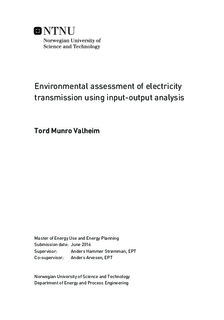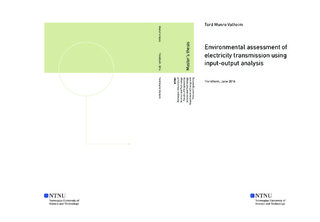| dc.description.abstract | The purpose of this master thesis was to present an environmental assessment of impacts related to electricity transmission. This was done with the use of two different case studies and by conducting an input-output analysis (IOA). An important transmission route located in Germany, and extensions of transmission lines contributing to renewable energy integration until year 2030 was chosen as case studies. Transmission technologies investigated in detail was overhead lines (OHL) and subsea cables, although other components such as underground cables (UGC) and air insulated substations (AIS) was also included in the assessment.
In the impact assessment, emissions of greenhouse gases (GHG), nitrogen oxides (NOx), total suspended particles (TSP), sulphur oxides (SOx), carbon monoxide (CO), and non-methane volatile organic compound (NMVOC) was calculated, with the main focus being on greenhouse gas (GHG) emissions.
The results showed a total impact of 92.5 Mton CO2-equivalents for developing the transmission grid to accommodate for integrating renewable energy to the electrical power grid. The subsea cable emerged as the main culprit, with 67% of the total CO2-eq emissions. The largest CO2-eq intensive transmission technology was found to be UGC, with six times more emissions per km compared to OHLs, and subsea cable with more than twice as high emissions, resulting in OHL as the least CO2-eq intensive transmission technology per km. For subsea cables, cable materials and installation represented the largest share of emissions, mainly due to the operation of marine vessels. For OHLs, activities related to constructing foundations for masts, erecting the masts and stringing the conductors represented the largest share of OHL emissions. Metal products and usage of electricity, generated from coal, was especially important contributors affecting the various types of emissions from OHLs. | |

